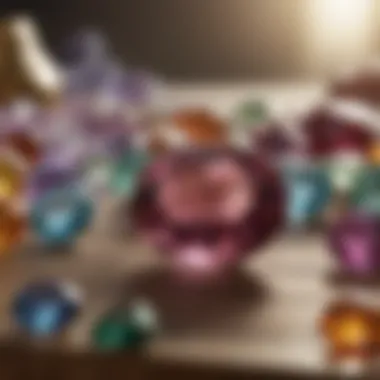Exploring Brilliant Earth Clarity in Gemstones


Intro
In the unique world of gemstones, clarity holds a significant place. The clarity of a gemstone not only determines its aesthetic appeal but also influences its value in the market. As we explore the nuances of clarity, we will delve into the grading systems that assess this quality and the impact it has on the perception of gemstones. Furthermore, we will focus on how clarity relates to sustainable sourcing practices, consumer trends, and effective tips for selecting high-quality gems. This article aims to provide a thorough understanding of Brilliant Earth Clarity, targeting gemstone enthusiasts, collectors, and professionals.
Gemstone Overview
Definition and Characteristics
Gemstones are precious or semi-precious minerals that have been cut and polished for use in jewelry or decoration. Their appeal often lies in their color, brilliance, and, importantly, their clarity. Clarity refers to the absence of inclusions (internal flaws) and blemishes (surface flaws). The clearer the gemstone, the more valuable it typically becomes. Various factors, such as the type of gemstone and its origin, can influence clarity.
Classification of Gemstones
Gemstones are classified into different categories based on several criteria, including composition and gemological properties. They can be broadly classified into precious stones, such as diamonds, rubies, sapphires, and emeralds, and semi-precious stones like amethysts and garnets. This differentiation is critical in understanding their respective grading and clarity assessments.
- Precious Gemstones: Noted for their beauty and rarity, these stones are usually more expensive than semi-precious ones.
- Semi-Precious Gemstones: While still appealing, these stones are generally more obtainable and less costly.
The clarity of these gemstones can vary widely, influencing their market appeal and desirability among collectors.
"Clarity is a critical determinant of gemstone value, influencing both appearance and market trends."
The next sections will delve into the historical significance of gemstones, exploring how ancient cultures valued them and what myths and legends have developed around these captivating stones.
Understanding Clarity in Gemstones
The importance of clarity in gemstones cannot be overstated. It serves as a fundamental indicator of quality and beauty, playing a vital role in determining the overall value of a stone. Clarity refers to the presence of internal or external flaws, commonly known as inclusions and blemishes. These imperfections can affect how light interacts with the gemstone, influencing its visual appearance significantly.
Clarity also has implications for the perception and desirability of gemstones. For collectors, jewelers, and enthusiasts, selecting a gem with high clarity can enhance the aesthetic appeal of jewelry. A clearer stone often reflects light in a more brilliant manner, making it visually captivating. The clarity also speaks volumes about the gemstone's origin and the natural processes that formed it, adding an element of intrigue.
In addition to aesthetic considerations, clarity impacts a gemstone's market value. Higher clarity levels generally lead to increased desirability and price. Therefore, understanding clarity is key for anyone involved in the gemstone industry. It informs purchasing decisions, enables informed conversations about stones, and fosters appreciation for the factors contributing to each gem’s unique character.
Defining Clarity
Clarity is defined in the gemstone industry as a measure of the visibility of internal and external characteristics. These characteristics are often the result of geological processes during the stone's formation. Inclusions may appear as tiny crystals, gas bubbles, or even fractures within the stone. Each gem type has a unique tolerance for these flaws, which means definitions of clarity can vary widely.
The Gemological Institute of America (GIA) and other grading bodies classify clarity on an established scale. This scale includes categories such as Flawless, Internally Flawless, Very Very Slightly Included, and others. Understanding these definitions helps both consumers and professionals assess the quality of gemstones accurately.
How Clarity Affects Gemstone Value
Clarity has a direct correlation with the value of a gemstone. The presence of inclusions and blemishes can lower a gem's worth, particularly in high-demand stones like diamonds, emeralds, and sapphires. A flawless diamond typically commands a significantly higher price than one with visible flaws.
In many cases, clarity can influence consumer choice as well. When purchasing, individuals often seek out stones that exhibit high clarity. Factors such as transparency and the play of light can make or break a sale. Moreover, suppliers and retailers may emphasize clarity in their marketing to attract discerning buyers.
In summary, clarity plays a crucial role in determining both the quality and value of gemstones. Understanding how clarity is defined and how it affects market prices offers essential insights into the world of gemstones.
The Gemstone Grading System
In the realm of gemstones, the grading system serves as a fundamental framework for understanding quality, including clarity. This system provides a structured approach to evaluating gems, ensuring that buyers and collectors can make informed decisions. By establishing a common language around gemstone attributes, the grading system enhances the transparency of the market.
One significant benefit of adopting the gemstone grading system is that it fosters trust between consumers and sellers. When buyers comprehend the grading criteria, they can better ascertain the value and authenticity of a gemstone. Moreover, reputable dealers often adhere to established grading standards, making it easier to identify genuine products and avoid counterfeits.
The grading system considers various elements, such as cut, color, clarity, and carat weight. Each element contributes a unique aspect to the overall value and appearance of the gemstone. Among them, clarity holds a pivotal role in determining the visual appeal and market demand of gems.


Overview of Gemstone Grades
Gemstone grades typically vary from lower to higher qualities. The most commonly recognized grading systems are those introduced by organizations like the Gemological Institute of America (GIA). These grades can be generally categorized into several classes, each reflecting the relative quality of the gemstones:
- Commercial Grade: Features noticeable inclusions but remains suitable for mass-market jewelry.
- Good Grade: Contains minor inclusions, visible only under magnification, making it ideal for everyday wear.
- Fine Grade: Exhibits minimal inclusions, often resulting in better quality pieces that attract discerning collectors.
- Flawless Grade: Virtually free of inclusions, showcasing the highest standard and attracting significant prices in the marketplace.
Understanding these grades allows enthusiasts to identify which gems meet personal or investment criteria.
Clarity Grades Explained
The clarity of gemstones is a critical measure of their overall quality and desirability. The clarity grading scale primarily considers the presence, size, and visibility of inclusions and blemishes. Here are common clarity grades used in the industry:
- Flawless (F): No inclusions or blemishes visible under 10x magnification.
- Internally Flawless (IF): No inclusions, but insignificant blemishes are visible.
- Very Very Slightly Included (VVS1, VVS2): Minute inclusions, difficult for a skilled grader to detect under 10x magnification.
- Very Slightly Included (VS1, VS2): Minor inclusions that are visible but do not affect the overall appearance.
- Slightly Included (SI1, SI2): Noticeable inclusions that may affect transparency; visible to a trained grader.
- Included (I1, I2, I3): Obvious inclusions that are easily seen, often impacting the gem's brilliance.
These clarity grades influence perceptions of value, guiding consumers toward high-quality selections while also affecting resale potential.
Recognizing Impurities
Recognizing impurities in gemstones is vital for proper assessment during the selection process. Inclusions may consist of various materials, including minerals or gas bubbles, that interrupt the crystal structure of a gemstone. Understanding the types of impurities helps in evaluating a gem's clarity:
- Naturally occurring inclusions: Often visible in colored stones, these occurrences can contribute to the gem's uniqueness and character.
- Fractures and cracks: Weak points that may lead to breakage, impacting durability and value.
- Bubbles or gas-filled inclusions: Found primarily in synthetic gems, indicating a lack of natural formation.
Potential buyers should perform due diligence when evaluating clarity. The presence of impurities may not always diminish a gem's value but may instead reflect its story. Understanding clarity and its nuances can make the difference between a successful purchase and a regrettable one.
"Clarity remains a central pillar in the art of gem evaluation, much like a guiding star for collectors and jewelers alike."
With clarity's crucial role firmly established, the discourse turns to the intricate relationships gemstones maintain with other attributes like color and cut.
Visual Impact of Clarity
The visual impact of clarity is a fundamental aspect of gemstone evaluation. Clarity directly influences not only the aesthetic appeal of a gem but also its market value. Examining how clarity interacts with other properties such as color allows for a fuller appreciation of gemstones. Understanding this relationship guides collectors and enthusiasts in making informed decisions.
Clarity vs. Color
When assessing a gemstone, one of the first considerations is its clarity relative to its color. Clarity determines how well light can pass through the stone, while color adds character and depth. In some cases, a highly colored gem may mask inclusions, making clarity less obvious. However, in clear stones like diamonds, clarity becomes critical.
A clear diamond may outshine a colored stone with visible inclusions simply due to its ability to reflect light effectively. It is essential for enthusiasts to recognize that harmony between clarity and color enhances a gemstone's overall beauty. Thus, the best investment often requires a balance, favoring clarity in lighter or colorless stones and color in more opaque ones while maintaining acceptable clarity.
The Role of Cut in Enhancing Clarity
The cut of a gemstone plays a crucial role in maximizing its clarity. A well-cut stone allows light to enter and exit, enhancing the visual effects of clarity. Poor cuts can lead to light leakage and dullness, diminishing the perceived quality of a gem.
High-quality gem cutters focus on maintaining clarity by strategically placing the facets. This tailored approach ensures that the stone reflects light optimally, revealing its brilliance. Different cuts, such as round, princess, or emerald, influence how clarity is appreciated. Ultimately, the cut not only showcases the clarity but also enhances the overall beauty, contributing to the gemstone’s allure.
Transparency and Its Effects
Transparency is closely linked to clarity. A transparent gemstone is typically more valuable because it allows light to travel through it freely. The effects of transparency can change drastically based on clarity.
For example, a transparent gem with high clarity portrays a distinct sparkle that captivates attention. In contrast, a stone with substantial inclusions may appear cloudy or dull regardless of its color. This cloudiness detracts from a gem’s brilliance and individuality.
"High clarity is associated with beauty and value in gemstones, making it a coveted characteristic for consumers."
Ethical Sourcing of Gemstones


The importance of ethical sourcing in the gemstone industry cannot be overstated. Consumers today are increasingly aware of the implications of their purchases. They seek transparency and accountability from retailers. Ethical sourcing focuses on acquiring gemstones in a manner that is both socially and environmentally responsible. It ensures that miners, workers, and communities do not face harsh conditions for the sake of profit. Additionally, this practice contributes to a sustainable future, benefiting the planet and its people.
When it comes to gemstones, ethical concerns are multifaceted. From the mining processes to the distribution channels, each step carries the potential for exploitation or harm. Consumers should choose brands that are committed to these values. This choice supports fair labor practices and encourages the maintenance of ecological balance. Furthermore, retailers that adhere to ethical sourcing can command higher trust from their customers.
Understanding Sustainable Practices
Sustainable practices in gemstone sourcing are key to reducing negative impacts on the environment and local communities. This means selecting gemstones that are mined with respect for biodiversity. Many organizations advocate for mining operations that follow guidelines to minimize environmental degradation.
For instance:
- Supporting small-scale miners who prioritize safe working conditions.
- Investing in technology that reduces waste during extraction.
- Promoting the use of recycled gemstones that lessen demand for new mining.
These practices have long-term benefits not just for the industry, but also for consumers who are increasingly interested in ensuring their purchases do not contribute to harm.
Clarity and Ethical Standards
Clarity and ethical standards are closely intertwined in the gemstone industry. The clarity of a gemstone often reflects the quality of its sourcing. High clarity levels can indicate a careful selection process, where stones are chosen based on both their natural beauty and the ethics surrounding their acquisition.
Adhering to ethical standards ensures that clarity is not just a measure of appearance, but also of integrity. Some crucial elements include:
- Certifying that gemstones are conflict-free, meaning they are not mined in war zones or areas with human rights abuses.
- Providing documentation that traces the gemstone's origin and extraction.
- Partnering with organizations that promote fair trade practices in the gemstone market.
"Both ethical sourcing and clarity are essential in building a jewelry market that reflects our values as consumers."
Consumer Perception of Clarity
Understanding consumer perception of clarity in gemstones is essential for both the buyers and sellers in the jewelry market. This aspect influences purchasing decisions significantly. The visibility of imperfections in a gemstone can affect its desirability and price. A clear gemstone often evokes feelings of value and luxury, which people associate with personal worth and social status.
The allure of clarity is not just about visual appeal; it extends to how consumers connect emotionally with their purchases. Many buyers seek stones that tell a story or symbolize a special moment. When clarity is emphasized, it enhances the narrative around the gemstone. Shoppers are often drawn to considerate choices, looking for the best quality possible, which makes clarity a critical aspect when evaluating options.
Moreover, consumer education plays a pivotal role in shaping perceptions. As buyers become more informed about gemstone quality factors, including clarity, they can make more confident decisions. This knowledge often influences their expectations and valuation of gemstones, leading to heightened demand for high-quality, clear specimens.
The Psychology of Clarity
Clarity serves as a psychological signal in the context of gemstones. It acts as a metric for quality and can drive assumptions about the wearer’s taste and lifestyle. A clearer gemstone might suggest discernment and social status. When individuals wear high-clarity stones, they often feel a sense of pride and confidence. This psychological effect can boost self-esteem and influence social interactions.
Impurities, on the other hand, can invoke negative perceptions. They might deter consumers who associate flaws with lower quality or value, impacting their purchasing behavior. This attachment to clarity as a desirable trait extends beyond sentimental value. Clarity impacts not just the aesthetics of a piece but also its market viability.
"Consumers subconsciously connect clarity with purity and perfection, which enhances the allure of fine jewelry."
Trends in Consumer Demand
In recent years, there has been a noticeable shift in consumer preferences concerning clarity in gemstones. Younger buyers are increasingly attentive to the origins and quality of their purchases. They tend to prefer ethically sourced, high-clarity stones that align with their values around sustainability and transparency.
Market trends indicate a growing demand for unique cuts and unconventional gemstones that maintain high clarity. This trend portrays a desire for individuality while still valuing quality. Accordingly, retailers are adapting, stockpiling unique entries that meet these evolving consumer demands.
In essence, clarity serves as a benchmark for overall value and desirability in gemstones. As these trends continue to evolve, the clarity of gemstones remains a pivotal consideration for consumers making informed choices.
Tips for Choosing Gemstones
Choosing gemstones is an essential aspect of both personal adornment and investment. As the article explores clarity, it is necessary to reflect on the broader spectrum of considerations involved in selecting the perfect stone. Clarity plays a significant role in determining the aesthetic and monetary value of a gem, but it is not the sole feature to weigh when making a purchase.
Evaluating Clarity in Gemstones


Clarity is a critical determinant in the value and beauty of gemstones. To properly evaluate clarity, one must examine the stone under appropriate lighting and at various angles. Here are some key factors to consider:
- Inclusions: Look for natural imperfections. They can affect light performance in the stone. More inclusions typically mean lesser clarity and reduced value.
- Blemishes: Surface blemishes, although they may not affect the stone's interior, can reduce its appeal.
- Gemstone Type: Different types of gemstones have distinct clarity standards. For example, diamonds are graded differently than sapphires.
- Professional Appraisal: Consulting certified gemologists can provide an objective evaluation, which is particularly useful for high-value purchases.
By actively engaging with these aspects, buyers can gain deeper insight into what constitutes a clear gemstone and make informed decisions.
Balancing Clarity with Other Factors
While clarity is a key aspect in evaluating gemstones, it is crucial to balance it with other factors like color, cut, and carat weight. Each of these elements contributes to the overall appearance and value of a gem. Here’s how each factor interplays:
- Color: In many stones, a vivid color may outweigh clarity. A highly saturated stone may be more desirable, even if it has minor inclusions.
- Cut: The cut of a gemstone can enhance its visual impact. A well-cut stone can reflect light better, disguising some minor flaws.
- Carat Weight: Larger stones can command higher prices, even if they have slightly lower clarity ratings.
Balancing these considerations ensures that one does not overly emphasize clarity at the expense of other vital characteristics. It is this harmony of features that ultimately results in a worthy selection.
Ultimately, a well-rounded approach to evaluating gemstones enhances overall satisfaction and investment value.
Market Trends Surrounding Clarity
Understanding the current market trends surrounding clarity is paramount for anyone involved in the gemstone industry. It informs decisions about sourcing, pricing, and marketing. As consumers become more knowledgeable and conscientious, their expectations around clarity also evolve. This section illuminates current preferences and the implications for jewelers and retailers.
Current Trends in Clarity Preferences
In recent years, there has been a noticeable shift in consumer preferences regarding gemstone clarity. More buyers are gravitating toward higher clarity grades, which directly influences the pricing and availability of these gemstones. The rise of eco-conscious consumerism plays a significant role in this change. Many individuals are now prioritizing not only the clarity but also the ethical sourcing practices associated with their gemstones.
The following factors are influencing these trends:
- Education: Increased access to information through the internet has enabled consumers to educate themselves about the importance of clarity. Websites and forums like Wikipedia and Reddit have become valuable resources for understanding gemstone quality.
- Sustainability: There is a growing market for sustainably sourced gemstones. Consumers are more willing to pay a premium for gemstones that are certified as ethically sourced and high in clarity.
- Aesthetic Appeal: Clearer gems are often perceived as more beautiful. They tend to reflect light more effectively and exhibit superior brilliance, enhancing their desirability.
Implications for Jewelers and Retailers
Jewelers and retailers must respond effectively to these trends to remain competitive. Here are some key implications:
- Adjusting Inventory: Retailers need to ensure their inventory reflects the growing demand for high-clarity gemstones. This might mean sourcing new suppliers or refining their purchasing strategies to emphasize clarity and ethical standards.
- Marketing Strategies: Marketing campaigns should focus on educating consumers about the significance of clarity and ethical sourcing. By highlighting these aspects, retailers can resonate with the values of today’s consumers.
- Pricing Strategies: With clarity becoming a more valuable asset, pricing strategies must be reevaluated. Retailers may find that clear gemstones command a premium, which can positively impact their bottom line.
"As consumers evolve, so too must our understanding of their desires; clarity is no longer just an advantage, it is a necessity."
Culmination: The Future of Gemstone Clarity
As we navigate the intricate landscape of gemstone clarity, it becomes clear that the future holds both challenges and opportunities. With increasing consumer awareness and a growing demand for ethically sourced gemstones, clarity assessment will evolve. This evolution is not solely about aesthetics but also encompasses ethical and sustainable practices.
Emerging Practices in Clarity Assessment
New methods in clarity assessment are being developed that will likely transform the industry. Technology, such as advanced imaging systems and AI tools, is playing a pivotal role. These technologies can identify inclusions and other clarity-related attributes more accurately and efficiently than traditional methods.
- Use of computer algorithms to analyze gemstone images
- Enhanced training for gemologists in using new tools
- Focus on objective measurement to reduce subjective biases
These practices promote consistency and transparency. They are vital for informing customers about the true nature of the gemstones they purchase. As environmental considerations become a priority, clarity assessment will also integrate sustainability metrics. This means evaluating not just the clarity itself but the broader impact of gemstone sourcing.
Clarity in a Changing Market Landscape
The changing market landscape further emphasizes the importance of clarity in the gemstone sector. As consumer preferences shift towards sustainability, clarity will be more essential than ever. Buyers are now more informed, seeking not only visually appealing stones but also those that align with their values. This shift necessitates that jewelers and retailers adapt their offerings accordingly.
- Increased demand for transparent sourcing practices
- Differentiation in product offerings based on clarity and ethical sourcing
- Innovative marketing strategies focusing on clarity and its benefits
The future of clarity in gemstones will likely see a greater emphasis on education. Consumers must understand clarity among other factors in making informed decisions. Retailers and jewelers have the opportunity to play a critical role by providing education about how clarity impacts beauty and value.
"Clarity is not just a feature; it is a commitment to ethical sourcing and consumer awareness."
In summary, the future of gemstone clarity will integrate advanced assessment methods and ethical standards, shaping a new era in gemstone purchasing and appreciation. As clarity remains a fundamental aspect of value, its role in sustainable practices will continue to grow, making it a key consideration for buyers, designers, and connoisseurs alike.







